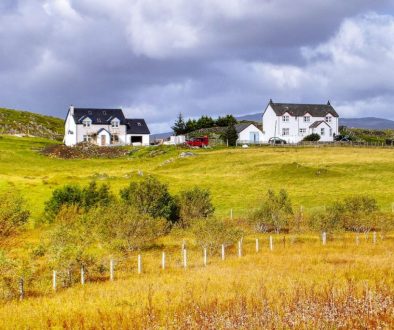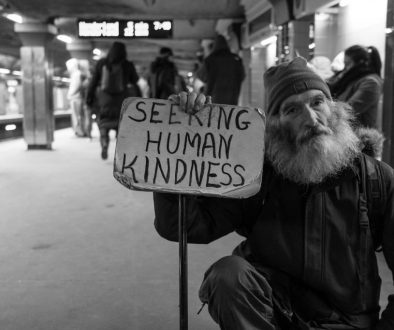How can we combat rural loneliness?
For many people, rural sights, sounds and communities are preferable to an urban lifestyle. But for others – particularly the young and elderly – rural living can be difficult, whether shopping for basic foodstuffs, accessing training or employment or socialising.
While loneliness and social isolation are not the same thing, both are closely related and can have a severe impact on quality of life. How lonely are countryside dwellers and what can be done about it? Jessica Sellick investigates.
Back in October 2013, the Health Secretary Jeremy Hunt described how “it is a source of national shame that as many as 800,000 people in England are chronically lonely… the problem of loneliness is that in our busy lives we have utterly failed to confront it as a society…Some five million people say television is their main form of company”. The remarks were made in response to data from the Campaign to End Loneliness.
This revealed, in the UK, 17% of older people are in contact with family, friends and neighbours less than once a week and 11% are in contact less than once a month; over half of people aged 75 years and over live alone; and 59% of adults aged over 52 years who report poor health say they feel lonely some of the time or often (compared to 21% who say they are in excellent health). With a plethora of reports, campaigns and initiatives, what is ‘social isolation’ and ‘loneliness’ and what does it mean for rural England? I offer four points.
First, what is loneliness and are there rural/urban differences in how it is experienced?
While the terms ‘loneliness’ and ‘social isolation’ are often used interchangeably, ‘social isolation’ is a measure of lack of relationships with other people whereas ‘loneliness’ is the subjective and negative judgement of the quality of these relationships. This means someone may be lonely and not socially isolated or social isolated but not lonely. In other words, there can be a mismatch between an individual’s actual and desired quality and quantity of social contacts.
While loneliness can occur at any time, it tends to affect more people in later life: perhaps through the loss of a partner or close friend, where family members or neighbours have moved away, ill health or through lack of confidence to go out. Equally, it can be an issue for young people, distanced from the services with infrequent, expensive public transport to reach them – how can young people meet friends after school/at weekends and get to sport and entertainment facilities?
Other ‘at risk’ groups include young care leavers, refugees, people with mental health issues and carers. Loneliness can be caused by intrinsic factors (i.e., people from some social groupings seem more vulnerable than others) and extrinsic factors (e.g. lack of transport, life events, personal circumstances).
There is little specific research comparing levels of loneliness between rural and urban areas. There is some data on social isolation but this is also limited. The Commission for Rural Communities published a report in 2012 considered social isolation experienced by older people. The report identified a number of challenges in a rural context: from dispersed populations and provision of services being more costly, to the impact of transport cuts and scope for preventive services.
More recently, a paper on village services highlighted several themes about the ways in which rural locations may exacerbate social exclusion for older people: from the rural premium inherent in service delivery to the loss of local shops and services and transport issues. Research on transport reveals that short travel distances required to access community activities is a key factor in high levels of community inclusion – yet the car dependent nature of travel overall means there is a high risk of mobility related exclusion in rural areas.
Taken as a collective, perhaps this literature goes some way to challenge the perception that close knit rural communities provide protection against the effects of social isolation, for many people this does not reflect the lived and practical realities of country living. Further, the impact of the recession/economic downturn and austerity on levels of loneliness and social isolation has not been fully explored in the literature yet.
Secondly, what is the impact of loneliness? According to research carried out by Professor John Cacioppo (University of Chicago), a sense of isolation can have an immediate, measurable effect on physical health: causing higher blood pressure and stress levels, depressing the immune system, disrupting sleep, encouraging overeating and alcohol consumption, and leading to an increased risk of Alzheimer’s.
Cacioppo believes human beings have evolved to depend on social networks and pangs of loneliness – like hunger and pain – are physical danger signs that there is a threat to an individual’s survival. His research led to debate in the popular press about whether ‘loneliness will kills you quicker than smoking ?While comparing smoking and loneliness may not be fair as predictors of poor health per se – indeed the World Health Organisation’s (WHO) ranking of loneliness as a higher risk to health than smoking or obesity has never been studied or published yet is also frequently cited in the media – there remains a growing body of work seeking to explore the relationship between loneliness and health.
A briefing by the Social Care Institute for Excellence (SCIE) found being lonely has a significant and lasting effect on blood pressure, with lonely individuals having higher blood pressure than their less lonely peers and that loneliness to be associated with depression (either as a cause or consequence). The Campaign to End Loneliness sets out the number of scales used in academic and large scale studies to measure levels of loneliness. This reveals how the effects of loneliness impact upon individual quality of life, the wider rural community, as well as health and social care services.
Studies have shown, for example, that isolated and lonely adults are more likely to be admitted earlier to residential or nursing care and at greater risk of emergency admission and re-admission to hospital. More recently, Age UK and the Campaign to End Loneliness jointly produced a report ‘promising approaches to reducing loneliness and isolation in later life’. This document seeks to close the gap between understandings what constitutes a ‘loneliness intervention’ (in the academic literature) with those involved in ‘delivering interventions’ (practitioner experiences).
Thirdly, what can be done to reduce loneliness and social isolation? Many initiatives in rural places are making a huge difference. These range from direct interventions (e.g. supporting existing relationships or new social connections); through to gateway services (e.g. technology, transport). In April 2015 a new report ‘hidden citizens – how can we identify the loneliest older adults?’ provided insights into how services targeting loneliness and isolation can be improved.
The document contains an example from Gloucestershire County Council (where a map of public health variables can be used to identify those at risk of isolation or loneliness). Many RSN members are familiar with or involved in Village Agent schemes across the country and/or befriending services. The Rural Coffee Caravan Information Project responds to some of the rural challenges identified above. The caravan is equipped with coffee, tea and homemade cakes, along with all sorts of information about organisations and the services on offer.
In April 2015 the ‘Talk Eat and Drink’ (TED) project was launched East Lindsey. Funded by the Big Lottery’s ‘fulfilling lives: ageing better’ programme, the District is one of fourteen areas in England receiving more than £2 million each to help elderly people feel happier. TED will see older people become more involved in social activities such as Sing for your Supper, fish and chips Friday and a Sunday pub lunch.
Fourthly, what does all this mean for policy and decision makers? In ‘later life in rural England’, Age UK calls upon all levels of Government to rural proof policies and services, to take the rural premium and social value into account, support whole community participation in local decisions and activities and reduce social isolation (e.g. through initiatives such as Village Agents).
The Local Government Association has a resources section on tackling loneliness and isolation, drawing on the Campaign to End Loneliness and Age UK’s work. Age Action Alliance is a partnership of 769 organisations and individuals working together to improve older people’s lives. Councillor Shelagh Marshall (the Older People’s champion at North Yorkshire County Council) outlines the important role local authorities can play in combating loneliness: from making it a priority in Health and Wellbeing Strategies, to encouraging older people to lobby their Council to tackle loneliness.
In April 2013, North Yorkshire Older People’s Partnership Board commissioned the University of York to undertake a project to bring together knowledge about the extent and nature of loneliness among older people and identify models of good practice in North Yorkshire. The Joseph Rowntree Foundation’s ‘neighbourhood approaches to loneliness programme’ looked at reducing loneliness in York and Bradford, working with residents, community researchers and local organisations.
he programme concluded that “community activism” can contribute to the wellbeing of people at risk of or experiencing loneliness. The Economic and Social Research Council (ESRC) is funding for a new seminar series (2015-2016) on ‘new perspectives on loneliness: developing theory, methodology and evidence for practice’. The grant will cover a series of workshops intended to develop understandings of the experiences of loneliness across a range of populations (older people, young adults) and places (rural locations, group settings such as care homes or university residences).
Overall, these campaigns, reports and initiatives highlight the need to identify (and often the difficulty in identifying) people who feel isolated and/or lonely as well as individuals and groups more vulnerable to becoming so. They also highlight the need of listening and hearing first-hand what kinds of support people would like. And they highlight the role that public, voluntary, community and private sectors might play in addressing these issues.
But what they also open up is a debate about whether we should and how to invest in services that help keep people connected to their communities. Amid further austerity to come; what positive and unintended impacts will tackling the deficit have on vulnerable people and who will be (should be) there to support them?
The impetus for this article came from Bassetlaw Public and Third Sector Partnership’s ‘Rural Social Isolation Group’. I am grateful to Rob Crowder at RCAN (Rural Community Action Nottinghamshire) for drawing my attention to the Partnership and Group’s work around volunteering, befriending, transport, village facilities, IT and housing/living support. The title for this paper ‘no one should have no one’ originates from Age UK.
Following a recent article on mental health, many of you have been in touch describing the local solutions you have developed. Improving Access to Psychological Therapies (IAPT) is an NHS programme rolling out services across England offering interventions approved by the National Institute of Health and Clinical Excellence (NICE) for treating people with depression and anxiety disorders.
This includes putting trained therapists into GP surgeries. Healtwatch York recently published a mental health guide. This document clearly sets out how to get help quickly, what you can do to look after yourself and where you can get advice, help and support. The journey to recovery (page 15) sets out the pathways for getting help. Police in Dyfed-Powys are working with health professionals to deliver a mobile triage service in rural areas for people in mental distress.
A £90,000 grant was approved by the Home Office Innovation Fund, which helped to pay for two bespoke vans equipped as mobile health consulting rooms. A police constable and health practitioner lead the service, known as the Mobile Assessment and Support Team (MAST), with another 10 trained officers and a group of health practitioners supporting them in delivering the scheme. A number of RSN Members are also in dialogue with health services (e.g. local acute trusts, Clinical Commissioning Groups) to ensure rural residents will be able to access medical facilities.
Jessica is a researcher/project manager at Rose Regeneration; an economic development business working with communities, Government and business to help them achieve their full potential. She is undertaking a mid-term evaluation of a Wellbeing Service, which aims to reduce hospital admissions and the need for long term residential care by putting in place a community package of support (e.g. equipment, adaptations, TeleCare) and completing a European project on ‘social value’.
Jessica’s public services work includes research for Defra on alternative service delivery and local level rural proofing. In her spare time Jessica volunteers for a farming charity that offers a 24/7 advice and support service for farmers, their families and the wider community with the purpose of ‘preventing things from getting to the desperate stage’.
Jessica can be contacted by email jessica.sellick@roseregeneration.co.uk or telephone 01522 521211. Website: http://www.roseregeneration.co.uk/ Twitter: @RoseRegen


